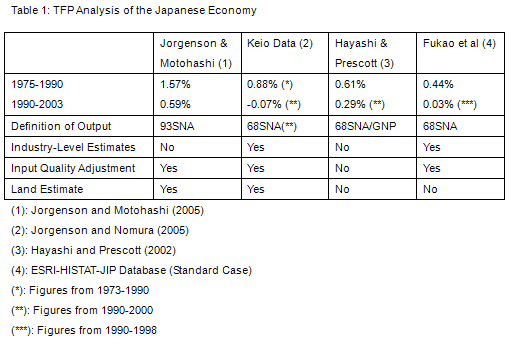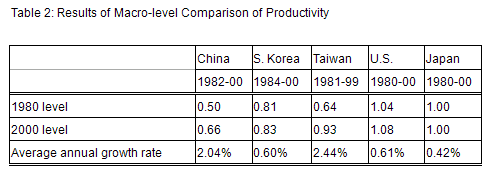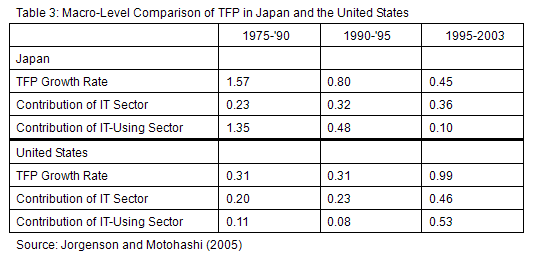Despite the recent steady recovery of the Japanese economy, medium- and long-term prospects for the economy are not necessarily bright amid the declining rate of fertility. In order to examine the future of the Japanese economy, it is essential to grasp the status of Japan's competitiveness. In this paper the author presents the analyses of productivity and innovation, he undertook at RIETI, and suggests prospects for the Japanese economy.
International comparison of macro-level productivity
First, this paper examines the status of Japan's recent economic recovery by reviewing the growth rate of the economy following the first oil crisis. The overall macroeconomic performance from 1975-1990 revealed an average annual growth rate of 4.0%, but the average fell to 1.3% between 1990 and 2004. Recently, economic growth rates in 2004 and 2005 were 2.3% and 2.7% respectively, and yet if the economic recovery is taken as a long-term trend, this rate is only one scene from the period of low economic growth that has persisted since the 1990s.
This economic growth rate can be broken down into the growth rates of the input of production factors, such as capital and labor, and total factor productivity (TFP). Table 1 compiles various analysis results to reflect the annual TFP growth rate from 1975-1990, and 1990 onward. According to Jorgenson and Motohashi (2005) the TFP growth rate until 1990 was 1.57, dropping nearly 1 percentage point to 0.59% thereafter. A variety of TFP estimates exist since data sources (macro-level and industry-level estimates) and estimation methodologies (e.g. whether or not estimate the quality of production factor) differ, yet the declining TFP growth rate is evident in each estimate.

In order to compare Japan's industrial competitiveness against other East Asian countries by using the productivity index, RIETI has undertaken the International Comparison of Productivity among Asian Countries (ICPA) project. To calculate comparable TFP by industry, the project developed a database relating to input-output tables and labor input and capital stock for Japan, the United States, South Korea, Taiwan, and China, benchmarking Japan's industrial competitiveness through international comparative analyses of TFP1.
Table 2 shows the results of this project's macro-level estimates. Although the time period under study varies by country, the table outlines the productivity level of each country for the beginning and end of its respective periods (where Japan=1), as well as the average annual productivity growth rate for the entire period. For example, China's TFP level was 50% of Japan's in 1982 but had risen to 66% by 2000, and its average productivity growth rate for the entire period was 2.04%.The higher productivity growth rates relative to Japan's 0.42% observed in China, South Korea, and Taiwan reveal that they are catching up to Japan in terms of productivity level. Meanwhile, relative to the U.S., which had a productivity level 4% higher than Japan's from the outset, its margin of difference had expanded to 8% in the 20 years. Contributing to this outcome was the decline in Japan's productivity growth rate from the 1990s; while on the other hand the U.S. saw its growth rate accelerate from the late 1990s.

R&D efforts and their efficiency
It is argued that a decline in the efficiency of business innovation activities has caused the decrease in the TFP growth rate since the 1990s and the decline in relative competitiveness from an international perspective (Sakakibara 2003).
Although R&D expenditures for private firms are on the rise, a temporary negative growth period occurred in the early half of the 1990s following the burst of the bubble economy. Furthermore, while the growth rate in the 1980s fluctuated between 5% and 10%, since the 1990s it has remained below 5% and the growth rate of investment in R&D has been declining. Despite the hypothesis that the marginal productivity of these investments in R&D has declined, analysis using firm-level microdata from the Ministry of Economy, Trade and Industry (METI)'s Basic Survey of Japanese Enterprise Activities drew out an estimate of approximately 20% for the latter half of the 1990s. There is no major difference in the averages when compared with similar analysis results (11%-42%) using pre-1990 data.2 In other words, in terms of innovation the decline in the TFP growth rate since the 1990s is believed to have been caused by a quantitative rather than a qualitative problem with R&D activities.
However, corporate managers often contend that the innovation efficiency of R&D investment has declined. The reason for this seems to lie in the major changes in the environment for innovation by Japanese companies. According to REITI's "Survey on R&D Colloborations with External Organizations," carried out in February 2004, many corporate leaders made efforts to undertake "market or needs-driven R&D" and "shorten lead time before commercialization." With the growing speed of technological innovation as seen in the IT area, East Asian countries are catching up to Japan and international competition surrounding innovation is intensifying. In light of this situation, corporate R&D division is increasingly needed to rapidly develop products that accurately reflect consumer needs. Therefore, as calls for a short-term return on R&D investment mount, a gap with reality is presumed to manifest itself in the recognition of a decline in R&D efficiency.
As market competition intensifies, the technological complexity required to realize innovation rises. To develop innovative products, efforts must be poured into basic research and new fields where no research has been carried out. Given this, Japanese firms are collaborating more actively with external partners in R&D activities. Japan's innovation system has been characterized by in-house R&D of large companies, yet small- and medium-sized enterprises (SMEs) have taken an important role in forming external partnerships in R&D. According to the author's research, high-tech startups and other small firms have achieved better results on R&D collaboration with external organization than major firms (Motohashi 2005).
IT revolution and the Japanese economy
Trends in both R&D and innovation are considered to have a major effect on TFP at the firm-level, yet technological innovation tends to concentrate on the manufacturing sector. When discussing macro-level productivity, it is important to conduct research on the relation with broader innovation, such as service innovation, in non-manufacturing industries and organizational reform of firms. Described below is the relationship between productivity and IT, which is strongly related to service and organizational innovation.
First I will introduce the results of a comparative analysis of sources of economic growth in Japan and the U.S., which is said to have achieved economic renewal at the macro-level through IT (Jorgenson and Motohashi [2005]). The impacts of IT innovation on macro-level productivity can be broken into the contributions of the IT-producing and IT-using sectors. The IT-producing sector, such as computers, has enjoyed a boost in productivity reflecting the effects of rapid technological innovations observed in Moore's Law and advances in Internet technology, and is considered to significantly contribute to changes in productivity at the macro-level. Technological innovations in the IT sector are also expected to accelerate efficiency in the business process of the IT-using sector, and contribute to a rise in productivity in the sector concerned.

As indicated in Table 3, a post-1990s decline in Japan's TFP growth rate is evident, showing a particularly strong decline in the latter half of the 1990s. In contrast, the TFP growth rate in the U.S. has been rising since the latter half of 1990s. A breakdown of these figures shows that the contribution of the IT sector to the TFP growth rate increased in both Japan and the U.S. In other words, the direct impact of IT innovation on productivity can also be witnessed in Japan. On the other hand, a decline in the TFP growth rate in Japan's IT-using sector also brought a drop in the productivity growth rate at the macro-level.
Further detailed analyses on this matter were conducted by Atrostic et al. (2005). Regarding the effect of information networks on productivity at the firm-level, investigations were carried out for both Japan and the U.S. based on the common framework. The results showed the TFP of Japanese firms using information networks to be 2.0% higher than those without one, with the differential in the U.S. at 4.4%, or twice the TFP of firms not using information networks. The absence of any major difference in the diffusion rate of information networks in Japan and the U.S. suggests that there is a problem in the way Japanese firms use IT. A close analysis on the type of information networks in Japanese firms shows that an intra-firm network has a 2.4% impact on productivity, while the inter-firm network has only a 1% impact. Despite introducing new inter-firm information systems as requested by client companies, it is believed that in many cases with SMEs the system was not utilized effectively.
There are several reasons for limited progress in the effective utilization of IT in Japanese firms. One is firms' inability to smoothly carry out reforms of business processes and organization following the introduction of a new information system. An IT system is a necessary tool for improving productivity, but if it cannot be utilized effectively it is no more valuable than a box. For example, in order for the introduction of a supply chain system to succeed, major operation is required, including product standardization, reviewing the production process, and arranging and consolidating suppliers. Only by all companies working together to resolve these issues can achieve the effects of IT implementation. Yet there is resistance from firms that are halting business reforms. In relation to this, it has been pointed out that in Japanese firms a separate IT system exists in each department, preventing the optimization of a company-wide network. Even if IT applications such as financial and accounting, ordering, and sales support systems are being used effectively in each department, the effects on firm performance are limited if there is no integrated intra-firm network. This appears to be related to the bottom-up decision-making mechanism, which is often observed among Japanese firms, and the resulting difficulty of implementing top-down reform.
Conclusion and future research agenda
In this paper we have verified through productivity analysis whether Japan's stagnant economic growth rate since the 1990s is attributable to loss of competitiveness. A macro-level analysis of growth factors shows that the declining rate of economic growth since the 1990s is greatly impacted by a drop in labor input and also, to a certain extent, by a drop in the TFP growth rate. Furthermore, an international comparative analysis of productivity suggests that East Asian countries such as China, South Korea, and Taiwan are catching up to Japan and that the gap between Japan and the U.S., where productivity was much higher from the outset, is widening. Analysis results regarding innovation were presented as the determinants of productivity. Results suggest that recent slowdown of economic growth in Japan is due to the declining growth rate of R&D investment. In addition, it is also found that the contributions of IT to productivity are limited due to the ineffective utilization of IT in Japanese firms.
Further analysis of the relationship between productivity and IT, which is strongly related to service and organizational innovation, is required from the perspective of the impact of innovation on the macroeconomy. The environment for innovation is rapidly improving, with service innovation utilizing IT including the increasing efficiency of distribution and upgrading of services through radio frequency identification (RFID), expansion of Internet transactions in the banking and securities sectors, and the spread of electronic money. Moreover, in terms of organizational reform it is necessary to conduct a more detailed analysis concerning the strengths and weaknesses of Japanese firms by comparing them to both U.S. firms, the top runners in IT use, and South Korean firms, which have enjoyed remarkable progress with recent organizational reforms. While maintaining a macro perspective, I would also like to dedicate future research at a more micro-level.


